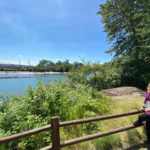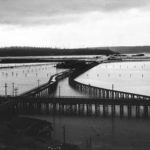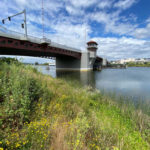Seattle owes its existence to its most invisible waterway
Jul 2, 2020, 9:44 AM
The beleaguered West Seattle Bridge isn’t there for no reason. It helps move people and cars across a busy industrial waterway far below the bridge and nearly invisible to most drivers and passengers.
While it may be invisible, the author of a new book says Seattle owes its very existence to that waterway, the Duwamish River.
The Duwamish River is thousands of years old, and it’s been home to indigenous people for millennia. It’s also the part of what became Seattle where European Americans first settled back in 1851, several months before the better-known Denny Party landed at Alki.
BJ Cummings is the author of a new book from University of Washington Press called “The River That Made Seattle: A Human and Natural History of The Duwamish.”
Cummings says that even though the lower stretches of the river are an infamously polluted Superfund site that empties into Elliott Bay right across from downtown, the Duwamish is also the city’s most invisible waterway. It’s far less visible – and much less known and celebrated – than Puget Sound, Lake Washington, Lake Union, or even Green Lake.
And Cummings should know better than just about anyone.
Cummings is community engagement manager for the UW Superfund research program. She’s been working on the Duwamish River for more than 25 years, first as the Puget Soundkeeper, and then as the founding director of the Duwamish River Cleanup Coalition, the group that helped secure Superfund listing for the river 20 years ago.
KIRO Radio met up with Cummings late last month on the west bank of the Duwamish opposite Kellogg Island, which is one of the last unaltered stretches of the old river.
For BJ Cummings, the Duwamish, and all the ways it has been radically reshaped and changed – and changed again – is a reflection of the city’s past and present.
“It’s really quite simple. Seattle has a hometown river,” Cummings said. “The Duwamish is our river. It’s our only river. It used to be that the Black and the Green and the White Rivers and the Cedar River and all of Lake Sammamish and all of Lake Washington, even Green Lake, drained out through the Duwamish River” before construction of what’s now the Hiram M. Chittenden Locks and other radical alterations to the landscape were made a hundred or so years ago.
“We altered not just this five miles of river, but the entire watershed, to the degree that now it’s only the Green River that flows into the Duwamish … it’s a single river system and it goes all the way up into the Cascade foothills,” Cummings said.
Just how different is that watershed – the lands that drain into the Duwamish – now?
“If you are up at Mount Rainier looking at Emmons Glacier? That was originally part of the Duwamish watershed. If you’re running around Green Lake? That was originally part of the Duwamish watershed,” Cummings said. Green Lake was larger in the past, Cummings says, and once drained into Lake Washington via what’s now Ravenna Creek, and Lake Washington drained, via the old Black River, into the Duwamish.
It was on that very different earlier iteration of the Duwamish River where Duwamish people lived for millennia before Europeans arrived. In her work on the river and in writing her book, Cummings has worked closely with the Duwamish Tribe and Duwamish voices, including James Rasmussen and Duwamish Tribal chair Cecile Hansen, who figure prominently in “The River That Made Seattle.”
In a Seattle Channel video produced in 2013 about the history of the river, James Rasmussen told this reporter, “When you ask the question, ‘What does the Duwamish River mean?,’ it’s kind of like asking ‘What does your grandmother mean?’”
Rasmussen’s point? For Duwamish people, it’s a fact of life that the river is a beloved and respected family member, and always has been.
For those who don’t know the Duwamish River as well, Cummings sees it as key to understanding the city’s identity. She says that it’s critical for people to know and understand how it’s been shaped and changed and polluted, and how it’s still an industrial area, and still being cleaned up.
“The richness of what this river provides is extraordinary, and that’s a lot of the history that I think we need to understand in order to understand who we are as a city,” Cummings said. “There would not be a Seattle without the Duwamish River.”
Seattle’s industrial growth in the late 19th and first half of the 20th century took place, in large part, on the banks of the Duwamish, with industry siting factories there that remain to this day. To better accommodate this industry, the old mudflats were replaced by Harbor Island and the East and West Waterways, and once-meandering channels were shaped into a rectilinear canal.
“The city was built on the resources of this river, kind of on the backs of the river’s own interests in a way,” Cummings said. “And the river was straightened and deepened and stripped of those resources human and natural resources in order to create the city of Seattle.”
“We don’t know who we are unless we know the Duwamish,” she added.
It’s not too late to get to know the Duwamish River, of course. One way is to read Cummings’ book. Another is to visit the one part of the Duwamish River that’s the least changed.
Kellogg Island is the one remaining natural river bend left on the Duwamish River in Seattle. The island and the narrow curving channel that separates it from the west bank survive because Cecile Hansen and others took a stand back in the 1970s.
Nearly 50 years ago, the Port of Seattle had cleared an area along the west bank of the river in preparation for development of a freight terminal or marina. When evidence of an ancient Duwamish village was discovered, work was eventually stopped. The project was delayed, and the Port of Seattle ultimately scrapped plans to build a freight terminal – to be known as Terminal 107 – at the site.
It’s at this spot, awkwardly named T-107 Park and inadvertently memorializing those scrapped plans, where the magic of Kellogg Island still comes to life, and where Cummings stood and described the odd juxtaposition of industry and nature.
“We have this beautiful natural riverbend and that gives us a little bit of a glimpse of what the Duwamish looked like before white settlement, and just off the shore we have an island with stretches of mudflats on the north side and lots of foliage, a little mini forest on the south side,” Cummings said.
“That island and the mud flats in particular are the only remaining original habitat on the river,” she continued. “We destroyed over 98% of the habitat here, and the only natural habitat that remains are those mudflats on the north part of the island.”
Though surrounded by heavy industry across the river, as well as upriver and downriver, Kellogg Island remains – or, has become – habitat for wildlife.
“We’re seeing flocks of birds flying around over there,” Cummings said. “You get eagles and herons and kingfishers and shorebirds here, and often we’ll see both harbor seals and river otters in this stretch as well.”
The natural history of the Duwamish River can be understood by examining what’s there now, and the industrial history of straightening the channel can be divined from old photos and nautical charts.
For instance, what’s now the Seattle neighborhood of Georgetown, Cummings says, was once a separate city built along the banks of the Duwamish. With straightening of the channel west of Georgetown, “the river was literally pulled away,” Cummings said, and the part of the old Duwamish that had flowed through Georgetown for perhaps thousands of years was filled in.
Cummings says that the straightening and industrialization of the river is well-documented. What’s harder to find, she says, are the stories of the people who were living along what had been a pristine river.
“The histories that were being written at that time and shortly after that time in the late 1800s and first part of the 1900s do not mention human beings at all,” Cummings said. “As far as [those earlier authors] were concerned, the people who were here were either invisible or irrelevant. So you just don’t see mention of the cultural resources here. You don’t see mentions of who they had to remove in order to industrialize this river. You see lots and lots and lots of history – the incredible engineering work that was done – and it stops there.”
But the human history never stopped, of course, and BJ Cummings says that in addition to indigenous Duwamish history, there are now seven generations of settler history with Germans, Irish, Mexican, Vietnamese and East African immigrants.
She says these stories are important, too, and hopes “The River That Made Seattle” will helps fill in some of the gaps in the history of the city’s most invisible waterway.
Cummings also says that the Port of Seattle is embarking on an effort to rename places like T-107 Park to better reflect the history – and to hopefully make those parks and other places to come face to face with the Duwamish River sound much more inviting.
BJ Cummings will be taking part in a series of free virtual events over the summer, including a book release talk at the Duwamish Longhouse on Saturday, July 11 and a panel discussion at Town Hall Seattle with James Rasmussen and others on Thursday, August 20.
You can hear Feliks every Wednesday and Friday morning on Seattle’s Morning News and read more from him here. If you have a story idea, please email Feliks here.























